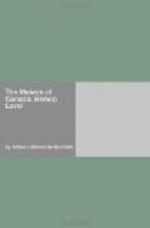But a new complication arose: the St. Andre, which had arrived on September 7th, brought to the Abbe de Queylus a new appointment as grand vicar from the Archbishop of Rouen, which contained his protests at court against the apostolic vicar, and letters from the king which seemed to confirm them. Doubt as to the authenticity of the powers of Mgr. de Laval might thus, at least, seem permissible; no act of the Abbe de Queylus, however, indicates that it was openly manifested, and the very next month the abbe returned to France.
We may understand, however, that Mgr. de Laval, in the midst of such difficulties, felt the need of early asserting his authority. He promulgated an order enjoining upon all the secular ecclesiastics of the country the disavowal of all foreign jurisdictions and the recognition of his alone, and commanded them to sign this regulation in evidence of their submission. All signed it, including the devoted priests of St. Sulpice at Montreal.
Two years later, nevertheless, the Abbe de Queylus returned with bulls from the Congregation of the Daterie at Rome. These bulls placed him in possession of the parish of Montreal. In spite of the formal forbiddance of the Bishop of Petraea, he undertook, strong in what he judged to be his rights, to betake himself to Montreal. The prelate on his side believed that it was his duty to take severe steps, and he suspended the Abbe de Queylus. On instructions which were given him by the king, Governor d’Avaugour transmitted to the Abbe de Queylus an order to return to France. The court of Rome finally settled the question by giving the entire jurisdiction of Canada to Mgr. de Laval. The affair thus ended, the Abbe de Queylus returned to the colony in 1668. The population of Ville-Marie received with deep joy this benefactor, to whose generosity it owed so much, and on his side the worthy Bishop of Petraea proved that if he had believed it his duty to defend his own authority when menaced, he had too noble a heart to preserve a petty rancour. He appointed the worthy Abbe de Queylus his grand vicar at Montreal.
When for the first time Mgr. de Laval set foot on the soil of America, the people, assembled to pay respect to their first pastor, were struck by his address, which was both affable and majestic, by his manners, as easy as they were distinguished, but especially by that charm which emanates from every one whose heart has remained ever pure. A lofty brow indicated an intellect above the ordinary; the clean-cut long nose was the inheritance of the Montmorencys; his eye was keen and bright; his eyebrows strongly arched; his thin lips and prominent chin showed a tenacious will; his hair was scanty; finally, according to the custom of that period, a moustache and chin beard added to the strength and energy of his features. From the moment of his arrival the prelate produced the best impression. “I cannot,” said Governor d’Argenson, “I cannot highly enough esteem the zeal and piety of Mgr. of Petraea. He is a true man of prayer, and I make no doubt that his labours will bear goodly fruits in this country.” Boucher, governor of Three Rivers, wrote thus: “We have a bishop whose zeal and virtue are beyond anything that I can say.”




